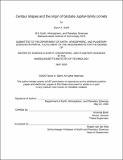| dc.contributor.advisor | Amanda Bosh. | en_US |
| dc.contributor.author | Safrit, Taylor K. | en_US |
| dc.contributor.other | Massachusetts Institute of Technology. Department of Earth, Atmospheric, and Planetary Sciences. | en_US |
| dc.date.accessioned | 2020-09-21T16:42:20Z | |
| dc.date.available | 2020-09-21T16:42:20Z | |
| dc.date.copyright | 2020 | en_US |
| dc.date.issued | 2020 | en_US |
| dc.identifier.uri | https://hdl.handle.net/1721.1/127665 | |
| dc.description | Thesis: S.M., Massachusetts Institute of Technology, Department of Earth, Atmospheric, and Planetary Sciences, May, 2020 | en_US |
| dc.description | Cataloged from the official PDF of thesis. | en_US |
| dc.description | Includes bibliographical references (pages 28-29). | en_US |
| dc.description.abstract | The bilobate shape distribution of Jupiter-family comets (JFCs) is of unconstrained origin. One theory is that JFC progenitors become bilobate in the Centaur region, where sublimation of volatiles from object surfaces may spin objects up beyond a critical limit and disrupt them. We examine models of rotational body stresses to learn about this disruption. We also present new observations of four Centaurs in an effort to further constrain the shape distribution of the Centaur population. Of these four, insufficient data were gathered for three (2014 KR101, 2013 TC146, and 2013 XZ8). The fourth (2014 QA43) is shown to have a rotational period of 11.558 hours and is at minimum 11.5% elongated. This is not commensurate with a bilobate shape; there remain no known bilobate Centaurs. | en_US |
| dc.description.statementofresponsibility | by Taylor K. Safrit. | en_US |
| dc.format.extent | 37 pages | en_US |
| dc.language.iso | eng | en_US |
| dc.publisher | Massachusetts Institute of Technology | en_US |
| dc.rights | MIT theses may be protected by copyright. Please reuse MIT thesis content according to the MIT Libraries Permissions Policy, which is available through the URL provided. | en_US |
| dc.rights.uri | http://dspace.mit.edu/handle/1721.1/7582 | en_US |
| dc.subject | Earth, Atmospheric, and Planetary Sciences. | en_US |
| dc.title | Centaur shapes and the origin of bilobate Jupiter-family comets | en_US |
| dc.type | Thesis | en_US |
| dc.description.degree | S.M. | en_US |
| dc.contributor.department | Massachusetts Institute of Technology. Department of Earth, Atmospheric, and Planetary Sciences | en_US |
| dc.identifier.oclc | 1193029178 | en_US |
| dc.description.collection | S.M. Massachusetts Institute of Technology, Department of Earth, Atmospheric, and Planetary Sciences | en_US |
| dspace.imported | 2020-09-21T16:42:18Z | en_US |
| mit.thesis.degree | Master | en_US |
| mit.thesis.department | EAPS | en_US |
